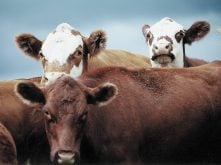This cattle market information is selected from the weekly report from Canfax, a division of the Canadian Cattlemen’s Association. More market information, analysis and statistics are available by becoming a Canfax subscriber by calling 403-275-5110 or at www.canfax.ca.
Fed cattle lower
Negative publicity about lean finely textured beef, dubbed pink slime, pressured cattle futures lower.
U.S. packer operating margins fell to the lowest point ever.
Cash prices fell sharply in the United States and Canada, with the Canfax weekly fed steer average at $109.75 per hundredweight, down $5.08, and heifers at $109.97, down $5.39.
Read Also

Organic farmers urged to make better use of trade deals
Organic growers should be singing CUSMA’s praises, according to the Canadian Chamber of Commerce.
Alberta rail grade steers averaged $184.50-$185.75.
For the past couple of weeks, U.S. buyers have procured lots of Canadian cattle, but despite this Canadian packers haven’t felt the need to bid aggressively.
For the fifth consecutive week, the show list had fewer captive supplies, but that failed to energize the cash market.
Weekly sales volume totalled 11,747 head, down one percent.
The cash to futures basis strengthened to -$7.97.
The average steer carcass is 881 pounds, up from 854 lb. last year at the same time. However, weights should fall as more calves enter the slaughter mix.
Poor feeding margins and increasing cost of gain could accelerate marketings.
Beef demand after Easter should pick up. Fed supplies should increase toward the end of the month as fall-placed calves start to appear.
Cow values rise
Canadian non-fed prices rose as the U.S. gears up to import more lean trim to make up for the loss of lean finely textured beef.
D1, D2 cows prices rose 57 cents per cwt. to average $77, while D3 cows were steady at $69.60.
Rail prices were about $1 higher to range from $140-$151.
Butcher bulls rose to average $88 per cwt.
Weekly exports of non-fed cattle to March 24 totalled 3,587 head, down one percent.
Feeder prices fall
Feeder volumes at auction declined seasonally.
The weaker fed market and higher barley costs drove feeder prices generally $1.50 per cwt. lower. Stockers lighter than 500 lb. fell $1.50-$3.
Heifers 500-600 lb. fell $2.50 while steers in the same weight class were moderately lower.
Auction volume during the holiday shortened week was 14,388 head, 46 percent lower than the previous week.
Struggling fed prices will likely keep pressure on feeders this week, but U.S. interest provides support.
Interest in grass cattle might strengthen with improved southern Alberta soil moisture.
Beef falls
The U.S. Choice cutout was $10.29 US lower than the same week last year and Select was down $8.64.
The Montreal wholesale market delivery this week was steady at $212-$214 Cdn.
Weekly Canadian cutouts to March 30 saw AAA and AA values fall slightly more than $2.60 per cwt., with AAA at $187.84 and AA at $184.82.
Canadian fed slaughter for the same week was nine percent smaller at 43,798 head.














